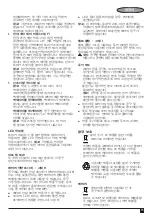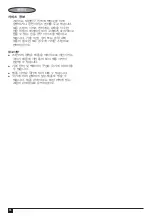
8
ENGLISH
SAVE THESE INSTRUCTIONS:
This manual contains
important safety instructions for battery chargers.
Before using charger, read all instructions and cautionary
markings on charger, battery pack, and product using
battery pack.
WARNING:
Shock hazard.
Do not allow any liquid to get
inside charger.
CAUTION:
Burn hazard.
To reduce the risk of injury,
charge only designated
Stanley
batteries. Other types of
batteries may burst causing personal injury and damage.
CAUTION:
Under certain conditions, with the charger
plugged in to the power supply, the charger can be
shorted by foreign material. Foreign materials of a
conductive nature such as, but not limited to, steel wool,
aluminum foil, or any buildup of metallic particles should
be kept away from charger cavities. Always unplug the
charger from the power supply when there is no battery
pack in the cavity. Unplug charger before attempting to
clean.
DO NOT attempt to charge the battery pack with any
chargers other than the ones in this manual.
The
charger and battery pack are specifically designed to work
together.
These chargers are not intended for any uses other
than charging designated Stanley rechargeable
batteries.
Any other uses may result in risk of fire,
electric shock or electrocution.
Do not expose charger to rain or snow.
Pull by plug rather than cord when disconnecting
charger.
This will reduce risk of damage to electric plug
and cord.
Make sure that cord is located so that it will not be
stepped on, tripped over, or otherwise subjected to
damage or stress.
Do not use an extension cord unless it is absolutely
necessary.
Use of improper extension cord could result in
risk of fire, electric shock, or electrocution.
An extension cord must have adequate wire size for
safety.
The smaller the gauge number of the wire, the
greater the capacity of the cable, that is 16 gauge has
more capacity than 18 gauge. When using more than one
extension to make up the total length, be sure each
individual extension contains at least the minimum wire
size.
Do not place any object on top of charger or place the
charger on a soft surface that might block the
ventilation slots and result in excessive internal heat.
Place the charger in a position away from any heat
source.
The charger is ventilated through slots in the top
and the bottom of the housing.
Do not operate charger with damaged cord or plug —
have them replaced immediately.
Do not operate charger if it has received a sharp blow,
been dropped, or otherwise damaged in any way.
Take it to an authorized service center.
Do not disassemble charger;
take it to an authorized
service center when service or repair is required. Incorrect
reassembly may result in a risk of electric shock,
electrocution or fire.
Disconnect the charger from the outlet before
attempting any cleaning.
This will reduce the risk of
electric shock. Removing the battery pack will not reduce
this risk.
NEVER attempt to connect 2 chargers together.
The charger is designed to operate on standard
household electrical power. Do not attempt to use it
on any other voltage.
SAVE THESE INSTRUCTIONS
Important Safety Instruction for Battery Packs
WARNING:
For safe operation, read this manual and
manuals originally supplied with tool before using the
charger.
The battery pack is not fully charged out of the carton.
Before using the battery pack and charger, read the safety
instructions below. Then follow charging procedures
outlined.
Read all Instructions
Do not incinerate the battery pack even if it is
severely damaged or is completely worn out.
The
battery pack can explode in a fire. Toxic fumes and
materials are created when LI-ION battery packs are
burned.
Do not charge or use battery in explosive
atmospheres, such as in the presence of flammable
liquids, gases or dust.
Inserting or removing the battery
from the charger may ignite the dust or fumes.
If battery contents come into contact with the skin,
immediately wash area with mild soap and water.
If
battery liquid gets into the eye, rinse water over the open
eye for 15 minutes or until irritation ceases. If medical
attention is needed, the battery electrolyte for Li-ion
batteries is composed of a mixture of liquid organic
carbonates and lithium salts.
Contents of opened battery cells may cause
respiratory irritation.
Provide fresh air. If symptoms
persists, seek medical attention.
WARNING: Burn hazard.
Battery liquid may be
flammable if exposed to spark or flame.
Charge the battery packs only in
Stanley
chargers.
DO NOT splash or immerse in water or other liquids.
This may cause premature cell failure.
Do not store or use the tool and battery pack in
locations where the temperature may reach or exceed
105°F (40C°) (such as outside sheds or metal
buildings in summer).
WARNING:
Never attempt to open the battery pack for
any reason. If battery pack case is cracked or damaged,
do not insert into charger. Do not crush, drop or damage
battery pack. Do not use a battery pack or charger that
has received a sharp blow, been dropped, run over or
damaged in any way (i.e., pierced with a nail, hit with a
hammer, stepped on). Damaged battery packs should be
returned to service center for recycling.
WARNING: Fire hazard. Do not store or carry battery
so that metal objects can contact exposed battery
terminals.
For example, do not place battery in aprons,
pockets, tool boxes, product kit boxes, drawers, etc., with
loose nails, screws, keys, etc.
Transporting batteries
can possibly cause fires if the battery terminals
inadvertently come in contact with conductive
materials such as keys, coins, hand tools and the like.
NOTE: LI-ION batteries should not be put in checked
baggage.
STORAGE RECOMMENDATIONS
1. The best storage place is one that is cool and dry away
from direct sunlight and excess heat or cold.
2. Long storage will not harm the battery pack or charger.
CHARGING PROCEDURE
Stanley
chargers are designed to charge
Stanley
battery packs in 40-60 minutes depending on the pack
being charged.
1. Plug the charger into an appropriate outlet before
inserting the battery pack.
2. Insert the battery pack into the charger. (Fig. B)
3. The LED will flash indicating that the battery is
being charged.
4. The completion of charge is indicated by the LED
remaining on continuously. The pack is fully charged and
may be used at this time or left on the charger.
CHARGER DIAGNOSTICS
This charger is designed to detect certain problems that can
arise with the battery packs or the power source. Problems are
indicated by one LED flashing in different patterns.
BAD BATTERY
The charger can detect a weak or damaged battery.
The LED flashes in the pattern indicated on the label. If
you see this bad battery blink pattern, do not continue
to charge the battery. Return it to a service center or a
collection site for recycling.
HOT/COLD PACK DELAY
When the charger detects a battery that is excessively
hot or excessively cold, it automatically starts a
Hot/Cold Pack Delay, suspending charging until the
battery has normalized. After this happens, the
charger automatically switches to the Pack Charging
mode. This feature ensures maximum battery life. The
light flashes in the pattern indicated on the label.
LEAVING THE BATTERY IN THE CHARGER
The charger and battery pack can be left connected with the
LED glowing indefinitely. The charger will keep the battery pack
fresh and fully charged. This charger features an automatic
tune-up mode which equals or balances the individual cells in
the battery pack to allow it to function at peak capacity. Battery
packs should be tuned up weekly or whenever the battery no
longer delivers the same amount of work. To use the automatic
tune-up mode, place the battery pack in the charger and leave
it for at least 8 hours.
IMPORTANT CHARGING NOTES
1. Longest life and best performance can be obtained if the
battery pack is charged when the air temperature is
between 65°F and 75°F (18°- 24°C). DO NOT charge the
battery pack in an air temperature below +40°F (+4.5°C),
or above +105°F (+40.5°C). This is important and will
prevent serious damage to the battery pack.
2. The charger and battery pack may become warm to touch
while charging. This is a normal condition, and does not
indicate a problem. To facilitate the cooling of the battery
pack after use, avoid placing the charger or battery pack in
a warm environment such as in a metal shed, or an
uninsulated trailer.
3. If the battery pack does not charge properly:
a. Check current at receptacle by plugging in a lamp or
other appliance
b. Check to see if receptacle is connected to a light switch
which turns power off when you turn out the lights.
c. Move charger and battery pack to a location where the
surrounding air temperature is approximately 65°F - 75°F
(18°- 24°C).
d. If charging problems persist, take the tool, battery pack
and charger to your local service center.
4. The battery pack should be recharged when it fails to
produce sufficient power on jobs which were easily done
previously. DO NOT CONTINUE to use under these
conditions. Follow the charging procedure. You may also
charge a partially used pack whenever you desire with no
adverse affect on the battery pack.
5. Foreign materials of a conductive nature such as, but not
limited to, steel wool, aluminum foil, or any buildup of
metallic particles should be kept away from charger
cavities. Always unplug the charger from the power supply
when there is no battery pack in the cavity. Unplug charger
before attempting to clean.
6. Do not freeze or immerse charger in water or any other
liquid.
WARNING: Shock hazard.
Do not allow any liquid to get
inside charger.Never attempt to open the battery pack for
any reason. If the plastic housing of the battery pack
breaks or cracks, return to a service center for recycling.
OPERATING INSTRUCTIONS
Installing and Removing the Battery Pack From the Tool
CAUTION:
Make certain the lock-off button is engaged to
prevent switch actuation before emoving or installing
battery.
1. To install battery pack: Insert battery pack (6) into tool as
shown in
Figure C
.
2. To remove battery pack: Depress the battery release
button (7) as shown in
Figure D
and pull battery pack out
of tool.
3.
Variable Speed Trigger Switch (Figure E)
To turn the tool on, squeeze the trigger switch (1). To turn
the tool off, release the trigger switch. Your tool is
equipped with a brake. The chuck will stop as soon as the
trigger switch is fully released. The variable speed switch
enables you to select the best speed for a particular
application. The more you squeeze the trigger, the faster
the tool will operate. Use lower speeds for starting holes
without a center punch, drilling in metals or plastics, or
driving screws. For maximum tool life, use variable speed
only for starting holes or fasteners.
NOTE:
Continuous use in variable speed range is not
recommended. It may damage the switch and should be
avoided.
4.
Forward/Reverse Control Button (Figure F)
A forward/reverse control button (2) determines the
direction of the tool and also serves as a lock off button.
To select forward rotation, release the trigger switch and
depress the forward/reverse control button on the right
side of the tool. To select reverse, depress the
forward/reverse control button on the left side of the tool.
The center position of the control button locks the tool in
the OFF position. When changing the position of the
control button, be sure the trigger is released.
NOTE:
The first time the tool is run after changing the
direction of rotation, you may hear a click on start up. This
and the impacting noise that the tool makes is normal and
does not indicate a problem.
5.
Quick Release Chuck (Figure G)
NOTE:
The chuck accepts 1/4 inch (6.35 mm) hex
accessories only.
Place the switch in the locked off (center) position or
remove battery pack before changing accessories.
To install an accessory
, insert the accessory into the
quick release chuck (4) until an audible click is heard to
ensure the accessory is locked in place.
To remove an accessory
, pull the chuck collar (3) away
from the front of the tool, remove the accessory and
release the collar.
NOTE:
The quick release chuck is spring-loaded. The
accessory will be ejected when the chuck collar is pulled
forward.
LED WORK LIGHT
When impact driver is activated by pulling the trigger switch (1),
the integrated LED work light (9) will automatically illuminate
the work area.
NOTE:
The work light is for lighting the
immediate work surface and is not intended to be used as a
flashlight.
BIT TIP STORAGE
Two magnetic bit storage slots (5) are built into the area on the
top of the tool.
Battery Fuel Gauge - Figure H
The tool is equipped with a battery fuel gauge (8).This can be
used to display the current level of charge in the battery during
use and during charging. It does not indicate tool functionality
and is subject to variation based on product components,
temperature and end-user application.
Checking battery charge during use:
Press the battery fuel gauge button (H1).
The three LEDs (H2) will illuminate indicating the percent
of charge in the battery (Figure H).
If LED light does not lluminate, charge battery.
NOTE:
This battery is designed to not operate when a charge
below 20% of its capacity is reached. After the battery
charge is depleated, the tool will not operate until after the
battery has been recharged.
BELT CLIP - FIGURE I
A belt clip (10) is provided which can be switched to either side
of the tool based on user preference for convenient access and
storage during use.
Caution:
Ensure the forward/reverse control button (2) is
in the center lock position before attaching tool to belt.
MAINTENANCE
Your Stanley tool has been designed to operate over a
long period of time with a minimum of maintenance.
Continuoussatisfactory operation depends upon proper
tool care and regular cleaning.
Your charger does not require any maintenance apart
from regular cleaning.
Warning!
Before performing any maintenance on the tool,
remove the battery from the tool. Unplug the charger
before cleaning it.
Regularly clean the ventilation slots in your tool and
charger using a soft brush or dry cloth.
Regularly clean the motor housing using a damp cloth. Do
not use any abrasive or solvent-based cleaner.
Regularly open the chuck and tap it to remove any dust
from the interior.
PROTECTING THE ENVIRONMENTS
Separate collection. This product must not be
disposed of with normal household waste.
Should you find one day that your Stanley product needs
replacement, or if it is of no further use to you, do not
dispose of it with household waste. Make this product
avail able for separate collection.
Separate collection of used products and
packaging allows materials to be recycled and
used again. Re-use of recycled materials helps
prevent environmental pollution and reduces the
demand for raw materials.
BATTERIES
Run the battery down completely, then remove it
from the tool.
NiCd, NiMH and Li-Ion batteries are recyclable. Take them
to any authorised repair agent or a local recycling station.
SERVICE INFORMATION
Stanley offers a full network of company-owned and
authorized service locations throughout Asia. All Stanley
Service Centers are staffed with trained personnel to
provide customers with efficient and reliable power tool
service.Whether you need technical advice, repair, or
genuine factory replacement parts, contact the Stanley
location nearest to you.
NOTES
Stanley's policy is one of continuous improvement to our
products and, as such, we reserve the right tochange
product specifications without prior notice.
Standard equipment and accessories may vary by
country.
Product specifications may differ by country.
Complete product range may not be available in all
countries. Contact your local Stanley dealers for range
availability.
Summary of Contents for STCI1802
Page 1: ...3 STCI1802 STCI1804 10...
Page 2: ......
Page 3: ...1 3 4 9 10 2 6 7 5 B 1 FIG A FIG B FIG D FIG C FIG E 8...
Page 4: ...2 10 H1 H2 FIG F FIG G FIG I FIG H...
Page 13: ...11 4 a b c d e f g 5 a b c d 6 a u u u u u u u u...
Page 15: ...13 u u u u u u 5 15 40C 105 F 1 2 60 120 1 u u u u 16 18 u u u u u u u u...
Page 18: ...16...
Page 19: ......
Page 20: ...90610594 06 2014...






































